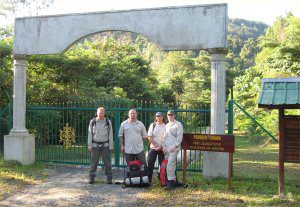 |
We arrive at the start of the Salt Route, a trek through the Crocker Ranges.
The gates weren’t due to open until a certain time in the morning but we found a way to squeeze between them and set off. |
| We had to walk up this enormous hill to get to the ranger station and register.
Permits are required for most National Parks in Borneo.
This is a good idea, as the money is used to police the park, keep them clean and pay towards the education of the children who live in the villages. |
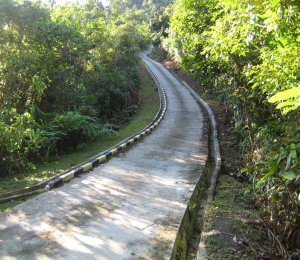 |
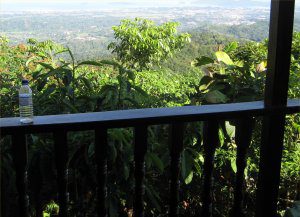 |
Looking out from the Balcony we could see back to the ocean.
The view was spectacular but sadly my camera couldn’t fully capture it.
The Crocker Ranges National park is twice the size of Singapore. |
| We wandered up hill through the Jungle. |
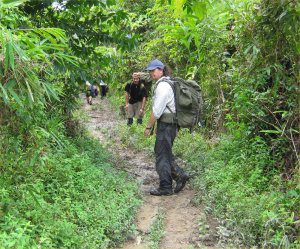 |
 |
And we wandered downhill through the Jungle. |
| An inevitable part of traversing a Jungle is crossing a rope bridge (they aren’t made of hemp anymore, so cable bridge would perhaps be a better name).
Memory’s of Indiana Jones were awakened, and I was reminded that you should only cross one at a time, no matter how secure the bridge looks. |
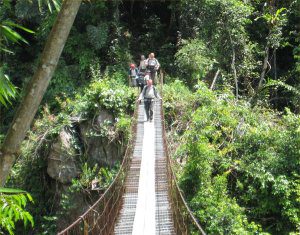 |
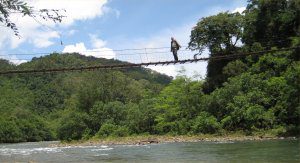 |
This picture shows a cross section of the bridge, giving some idea of its length. |
| This picture shows the height.
The water bellow is pretty fast flowing in the middle.
If you fell in you could be some way own the river before you the drag of the water stopped pulling you. You would also have been molested by the various parasites that live in the river. |
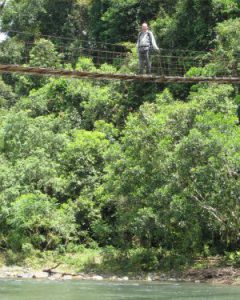 |
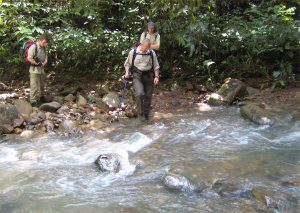 |
On other occasions, it was necessary to do more basic river crossings.
There are some sophisticated ways to do this, including using a pole, 3 people holding onto each other, and various stuff involving ropes, or using your rucksack as a flotation device.
In this instance, we just walked quickly through the water being careful about where we put our feet.
Dan starts to cross. |
|
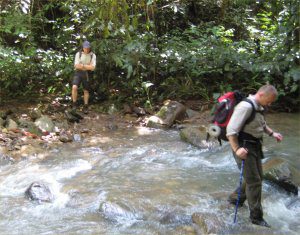 |
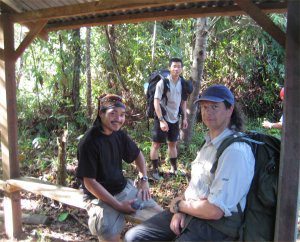 |
And successfully completes the crossing assisted by a carefully placed walking pole. |
| We stop at one of the simple shelters along the route (some of them had been built by the Rotary club). On the left of this picture is the excellent Mr Mickey.
Although friendly, formalities were always adhered to. He called me Mr John and I called him Mr Mickey.
In the background, is one of Mr Mickey’s porters, and on the right, our own indigenous guide of the West Midlands, JK. |
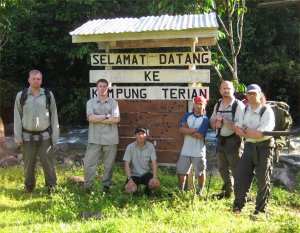 |
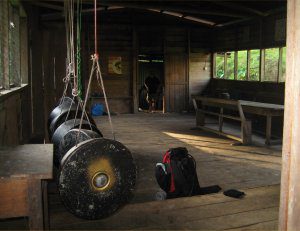 |
Our first night. We have accommodation at the village hall. It was built by the Government, and belongs to the people of the village.
It was very comfortable and set the right balance (the villagers do get trekkers parading through their village occasionally, but they see the benefit from it in rent and the availability of a meeting hall).
Along the left, are the traditional chimes that Dan and I had seen in the Sabah Museum, early that week.
As I set up my bed for the night I regretted not bringing my thermarest. Since the hut was so warm, I didn’t actually need to sleep in my sleeping bag, so used that as an improvised mattress instead.
At the back of the room, is the Kitchen. |
| I hadn’t realised, that all our cooking would be done by the “lads”.
It was humbling to see them carry 3 times the weight of my rucksack, and when we finally arrive at our destination, their first thought was to make us a cup of tea and begin preparing our dinner. |
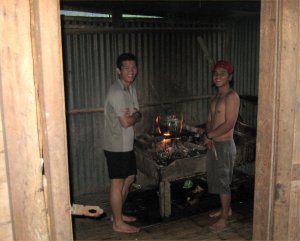 |
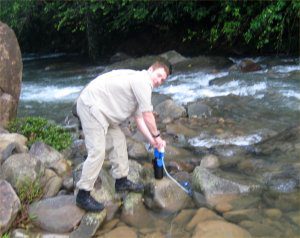 |
One thing I hadn’t realised, was just how isolated we were.
It wasn’t possible to buy water, it had to be pumped from the river.
It was then I found out, where the Trek takes its name.
Just about everything the villagers needed was provided by the Jungle.
The only exception to this was Salt which in times gone by, had to be carried in on the backs of porters. |
| I had heard a lot about Leeches in the Jungle.
They never actually “got” me, but Dan agreed to pose for this picture so that you can see what one looks like. |
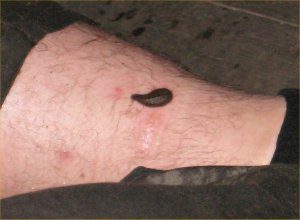 |
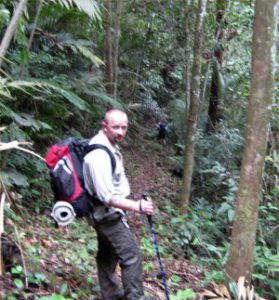 |
The following day we hit the trail again.
We wander downhill through dense jungle. |
| We wander uphill through dense jungle (in a 3 stooges pose). |
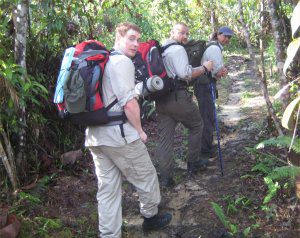 |
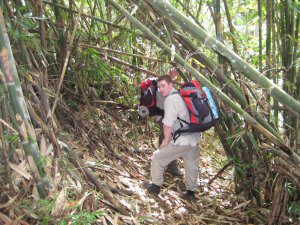 |
Down again (this time through fallen bamboo). |
| And then back to the flat. |
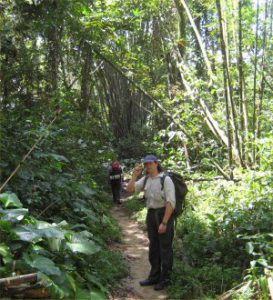 |
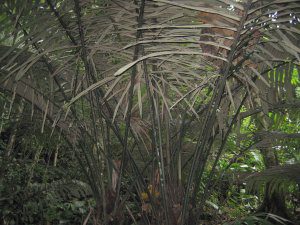 |
Some of the amazing vegetation along the route. |
| I didn’t see a lot of birds perched on this tree !. |
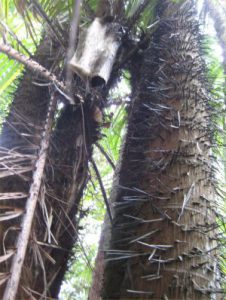 |
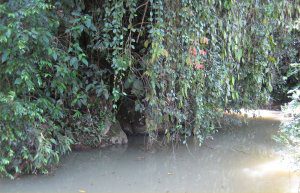 |
A pond next to the path with a sort of weeping willow tree overhanging.
It looked very serene and peaceful, but I was told that the water in the pond was so dirty, it would give you dysentery just from contact with your eye’s. |
| The highest point on the trail, is marked with this sort of triangular “thing”.
Never mind, it was more about the celebration than the “monument”.
We knew at this point, that the path wouldn’t go any higher. |
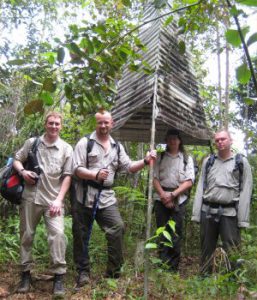 |
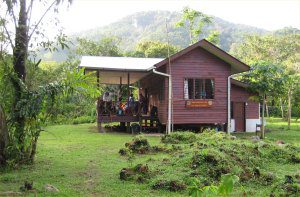 |
As we reach our next destination by late afternoon.
We arrive at the ranger station (there were no bears there looking for picnic baskets). |
| I was delighted to see that the local lads had made this superb hammock using bailing twine.
They were busy making another when we arrived.
I gave the hammock a try-out, and it was very comfortable, if a little short. |
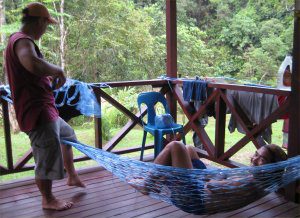 |
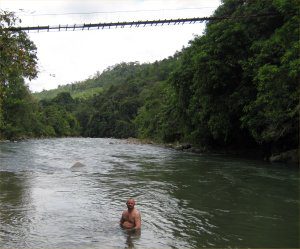 |
We all rest, and get cleaned up as best we can.
The bridge above Dan, would feature heavily, in the following mornings adventures. |
| I decide its time to put my hammock into action (after some minor mithering by JK, who correctly told me I would regret it, if I didn’t spend a night in my hammock, in the Jungle).
I consult with JK the self styled God of Hammocks for technical assistance. |
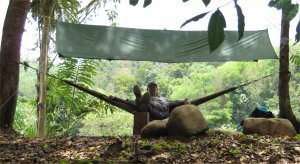 |
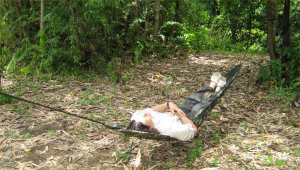 |
JK points out that the key to the success of the project is the sitting of the hammock.
We find 2 appropriately distanced trees and then tie up (the hammock, not each other).
At this point, its essential to lie in the hammock and take the stretch out of it.
Once done you get out and re-tighten it, repeating the process until all the stretch is gone.
There will always be a little stretch left, but this adds to the comfort and overall sleeping experience. |
| Camouflage isn’t normally my colour but the Hammock I bought had been recommended by JK and it was certainly up to the job.
It had a very comfortable base, a sewn in mozzy net and a basha to go over the top and keep out the rain.
Various modifications were recommended like sticks tied in to stop drips and gaffa tape which insects wont walk across.
I decided since it was a first outing that I would stick with convention. |
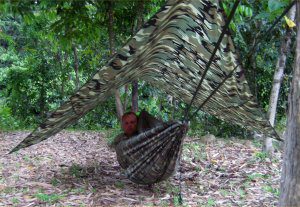 |
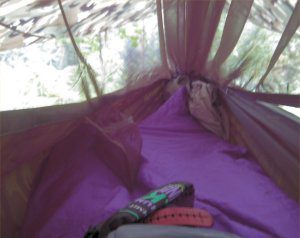 |
The view from inside my Hammock.
I didn’t need a sleeping bag at all, and just slept in my sleeping bag liner.
I didn’t realise, just how exhausted I was, and rested/slept in there for nearly 20 hours.
I woke with a start at one point but thought nothing of it.
I found out in the morning that a water buffalo had attacked the hammocks and JK had been forced to get out of “bed” and chase it away. |
| Earlier in the afternoon, I caught up with the lads (over black tea) as they played cards. |
 |
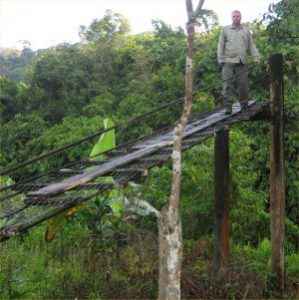 |
In the morning, I wake early and decide to go exploring.
JK had mentioned a bridge that was quite “exciting”.
You can see on my right, that the support strut is missing. |
| As I head out across the bridge it lists heavily to one side.
I keep a tight hold and pose for this picture (one of my favourite’s throughout all my travels). |
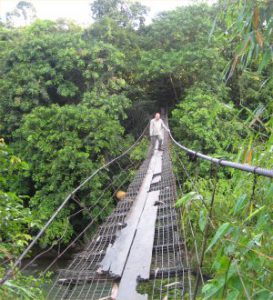 |
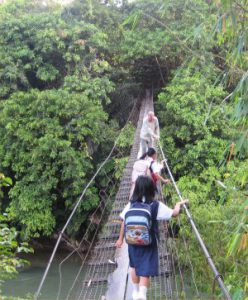 |
What’s this !.
The children from the local village set off for school.
Unlike at home in England, where education is perceived to be free, and therefore not valued, these children are on a mission to get to school, and won’t allow anything to get in their way. |
| …Not even me.
As I calmly explain to the Children that we will need to pass each other carefully, they are having none of it.
They boldly charge across the bridge and I am forced to grab the cable on my right.
The cable offered little more than psychological support and for one terrifying moment I thought I was actually going to fall into the water 40 feet bellow. |
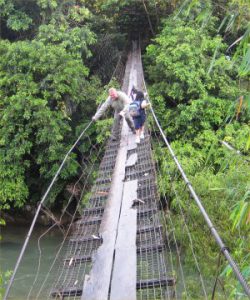 |
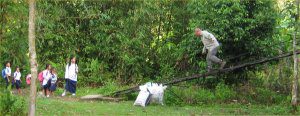 |
I quickly make my way back to the front of the bridge and not a moment too soon.
Another legion of Children are about to head across.
The “lead” child (a girl of about 13) smiled at me, but looked as though she wondered what the hell I was doing in the Jungle. At that moment I wondered as well !. |
| Up and out.
We quickly pack our stuff away and continue along the route.
You can see from this picture, that some of it was very thick mud, which took some real work to traverse through. |
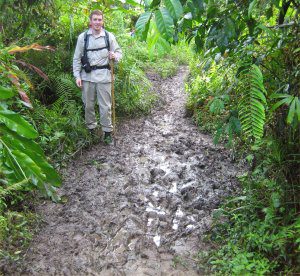 |
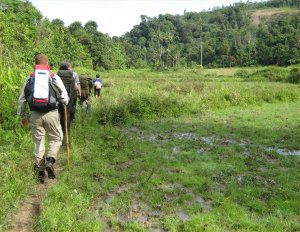 |
Further along and things dry out a little as we wander across the paddy field of another nearby village. |
| There was some debate to the correct name of these creatures.
I thought they were wild boars. It was pointed out that since they lived on a farm they weren’t any more wild than me.
Domestic Boars, Farm Boars, Field Boars, none of them seemed to sound quite right.
On the bottom right of the picture, you can see a superb example of primitive technology put to work.
With a few chops of the Parang, this piece of bamboo becomes a perfect trough for the Boars (type unknown). |
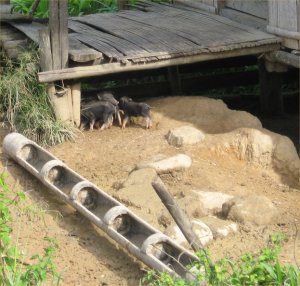 |
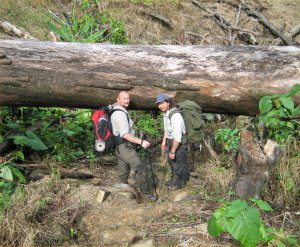 |
A section of the trail was flooded due to rain.
Mr Mickey, had worked out an exit route for us.
We wandered downhill for a while, through a demolished forest, and we pass under this enormous felled log. |
| The first time I’ve seen a road for 3 days, we head up this track, to get to our extraction point (does that sound too military ?).
It was really hard work and Dan and I had to focus really hard, to get to the top.
Luckily JK and Richard were there to motivate us. By taking of up the hill as fast as they could, and not even glancing backwards, Dan and I knew we were all in the thick of it together :(. |
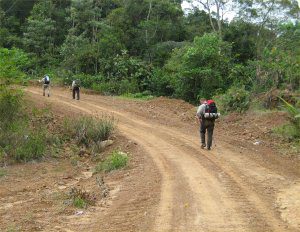 |
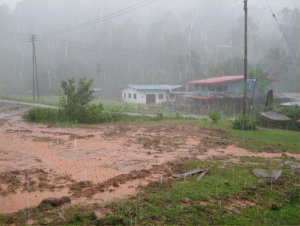 |
We reach our camp, and are once again (thankfully) put up in the local village hall.
At that moment, the heavens opened.
You can see from this picture why its called the rain forest. |
| Another game of cards is pursued and some “cans” are procured by a colleague of Mr Mickey.
We also got a few cans of coke as well. We had plenty of water, but there was nothing as refreshing as the taste of Coca Cola. |
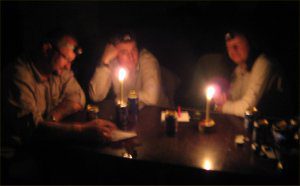 |
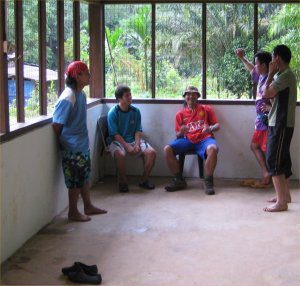 |
In the morning, we all pack up to return home.
Mr Mickey, Ridley and the others reverted to “street” dress, and they can be seen here in Rip Curl and other designer labels. |
| For the final morning the lads decide to take it easy and not cook breakfast.
Instead they take us to a cafe frequented by locals as a treat (which they very kindly paid for).
I didn’t feel much like eating so I just drank some water.
It was interesting to see the kind of place that a typical KK resident would take breakfast in. |
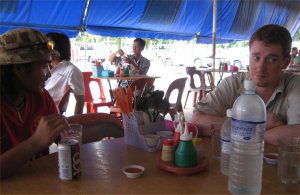 |
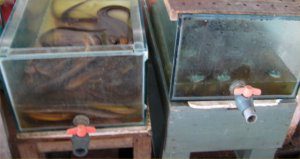 |
Also interesting were some of the more exotic foodstuffs on display.
The tank to the left is full of live Eels and the one to the right live frogs. |
| What a brilliant trip.
Id like to thank Dan, Richard and JK for their company and putting up with me during this adventure.
I have to say that some adventures, are pretty uncomfortable when your doing them, and that the real joy comes from reliving the experience. This was one of them.
I would also like to thank Mr Mickey, Ripley and the others (who’s names I heard but couldn’t pronounce, let alone spell) for making it such a superb trip. |
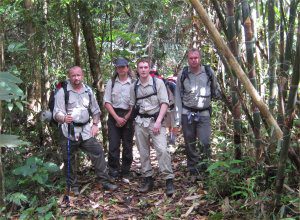 |